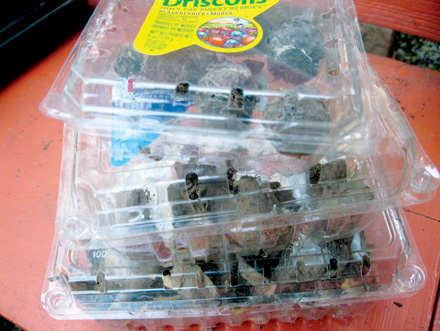14 Fall Garden Chores

Welcome, fall, a season when gardeners try to get a head start on next year. The following are my top 14 fall garden chores, in no particular order:
1. Get plants ready to bring inside. Trim off extra growth to reshape your plants into a manageable inside size. Spray with dishwashing liquid drops in water to remove hitchhikers. Determine good lighting spots for the plant needs.
2. Plant trees. Make sure to check how big the tree will get when mature and select an appropriate location for that size. Dig the hole at least twice the size of the root ball, it does make a difference.
3. Plant spring bulbs. If you don’t have moles and voles digging underground highways for mice, have fun planting spring bulbs: tulips and crocus are spring favorites. They are also favorite mice food. If you do have wildlife going wild, then choose daffodils, which are almost fool proof. Plant them towards the back of a flower bed so summer-growing plants cover them as their leaves turn yellow late spring. Don’t cut those off once the bulbs have bloomed or you won’t have flowers next year.
4. Plant garlic. Get garlic bulbs at local garden centers or clean out your refrigerator crisper. Divide the garlic bulbs and get them planted before the first frost. You should have garlic for cooking next year.
5. Harvest your bounty. It has been a late season for my tomatoes, onions and peppers this year but there is still time to harvest and store for winter. I freeze some of my bounty in plastic bags for soup-making later.
6. Weed and mulch your garden bed. If you weed now, you can remove plants with seeds and hopefully reduce next year’s weeds. Compost those plants after removing seed heads. Mulch your garden bed: hay, cardboard, grass clippings, non-treated wood chips all work well to amend your soil.
7. Make note of what you grew where. The general rule of thumb is to not plant the same thing in the same spot for more than two years in a row.
8. Bring in ceramic, terra cotta and other delicate pots. Ceramic terra cotta pots are not winter hardy so bring them into a garage or a storage shed. I left one out last year and watched ceramic pieces fall off the sides.
9. Wash, clean and store pots. You don’t want to harbor bugs or diseases so wash out plant pots before storing. It’s a nice way to get a head start on spring planting.
10. Stop fertilizing roses. Trim them and mulch.
11. Make notes about what happened this year and what you want to do next year. Don’t assume you will remember; I know I don’t.
12. Stock pile mulch. Those dry leaves make a great covering so try not to get too enthusiastic with your rake. Let them stay where they fall. If you want to run the lawn mower over them one last time this season, go for it, that will make the leaves decompose faster. For me, I would rather grab a cup of tea and supervise the leaves falling.
Charlotte Ekker Wiggins is a certified gardener, beekeeper and sometimes cook. Copyright 2016 used with permission, all rights reserved. This material may not be published, broadcast, rewritten or redistributed. Contact Charlotte at chargardens@gmail.com.

LEAVE AIR HOLES – 14. Clear plastic fruit clam shells work well to store bulbs until they can be planted in the fall for spring blooms. (Photos by Charlotte Ekker Wiggins).

MUM’S THE WORD – 13. Broken chrysanthemum branches can be stuck in the ground and kept watered. By next spring, you should have perennial mum starts.



Facebook Comments